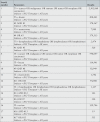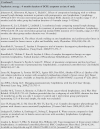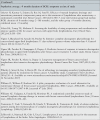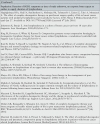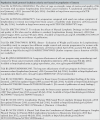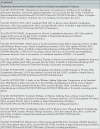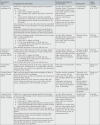Clinical effectiveness of decongestive treatments on excess arm volume and patient-centered outcomes in women with early breast cancer-related arm lymphedema: a systematic review
- PMID: 29419623
- PMCID: PMC5828398
- DOI: 10.11124/JBISRIR-2016-003185
Clinical effectiveness of decongestive treatments on excess arm volume and patient-centered outcomes in women with early breast cancer-related arm lymphedema: a systematic review
Abstract
Objective: To identify the effect of decongestive lymphedema treatment on excess arm volume or patient-centered outcomes in women presenting within either 12 months or a mean nine months of developing arm lymphedema following breast cancer treatment.
Introduction: Lymphedema is a common consequence of breast cancer treatment requiring life-long treatment to reduce symptoms and prevent complications. Currently, evidence to inform the optimal decongestive lymphedema treatment package is lacking.
Inclusion criteria: The review included studies on women who received lymphedema treatment within either 12 months or a mean of nine months of developing unilateral breast cancer-related arm lymphedema. The intervention was any decongestive lymphedema treatment delivered with the purpose of reducing arm lymphedema, compared to another form of lymphedema treatment (whether self or practitioner-administered), placebo or no treatment. The clinical outcome was excess arm volume; patient-centered outcomes were health-related quality of life, arm heaviness, arm function, patient-perceived benefit and satisfaction with treatment. Experimental study designs were eligible, including randomized and non-randomized controlled trials, quasi-experimental, prospective and retrospective before and after studies were considered.
Methods: A three-step search strategy was utilized to find published and unpublished studies. The search identified studies published from the inception of each database to July 6, 2016. Reference lists were scanned to identify further eligible studies. Studies were critically appraised using appropriate standardized critical appraisal instruments from the Joanna Briggs Institute. Details describing each study and treatment results regarding outcomes of interest were extracted from papers included in the review using appropriate standardized data extraction tools from the Joanna Briggs Institute. Due to heterogeneity in included studies, results for similar outcome measures were not pooled in statistical meta-analysis. A narrative and tabular format was used to synthesize results from identified and included studies.
Results: Seven studies reporting results for outcomes of interest were critically appraised and included in the review: five randomized controlled trials and two descriptive (uncontrolled) studies. Reported outcomes included excess arm volume (five studies), health-related quality of life (three studies), arm heaviness (one study), arm function (two studies) and patient-perceived benefit (two studies). There was some evidence that decongestive treatments were effective for women presenting within either 12 months or a mean of nine months of developing breast cancer-related arm lymphedema, but the wide range of data prevented comparison of treatment findings which limited our ability to answer the review questions.
Conclusions: Weak evidence (grade B) for the impact of decongestive lymphedema treatment on women with early lymphedema (i.e. less than 12 months duration of BCRL symptoms) did not allow any conclusions to be drawn about the most effective treatment to be offered when these women first present for treatment. Findings provided no justification to support change to current practice.Future primary research needs to focus on the most effective treatment for women when they first present with lymphedema symptoms, e.g. treatment provided within 12 months of developing symptoms. Studies should be adequately powered and recruit women exclusively with less than 12 months duration of breast cancer-related lymphedema symptoms, provide longer follow-up to monitor treatment effect over time, with comparable treatment protocols, outcome measures and reporting methods.
Conflict of interest statement
There is no conflict of interest in this project.
Figures
References
-
- DiSipio T, Rye S, Newman B, Hayes S. Incidence of unilateral arm lymphoedema after breast cancer: a systematic review and meta-analysis. Lancet 2013; 14 6:500–515. - PubMed
-
- CRUK. Breast cancer statistics. http://www.cancerresearchuk.org/cancer-info/cancerstats/types/breast/inc... Research UK [internet]. 2014 [accessed 28/4/2017]. Available from: http://www.cancerresearchuk.org/cancer-info/cancerstats/types/breast/inc....
-
- Rockson SG, Rivera KK. Estimating the population burden of lymphedema. Ann NY Acad Sci 2008; 1131 1:147–154. - PubMed
-
- Shih YC, Xu Y, Cormier JN, Giordano S, Ridner SH, Buchholz TA, et al. Incidence, treatment costs, and complications of lymphedema after breast cancer among women of working age: a 2-year follow-up study. J Clin Oncol 2009; 27 12:2007–2014. - PubMed
Publication types
MeSH terms
Substances
Grants and funding
LinkOut - more resources
Full Text Sources
Other Literature Sources
Medical





